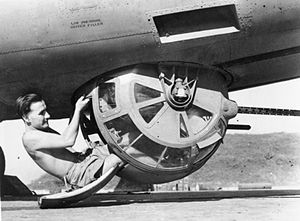Ball turret
| Ball Turret | |
|---|---|

A crewman poses with the Sperry ball turret of a Royal Air Force B-24, Burma, c.1943-1945
|
|
| Service history | |
| Used by | United States, United Kingdom, China |
| Wars | World War II |
| Specifications | |
| Caliber | .50 BMG |
A ball turret was a spherical-shaped, altazimuth mount gun turret, fitted to some American-built aircraft during World War II. The name arose from the turret's spherical housing.
It was a manned turret, as distinct from remote-controlled turrets also in use. The turret held the gunner, two heavy machine guns, ammunition, and sights. The Sperry Corporation designed ventral versions that became the most common version, thus the term "ball turret" is most specific to these versions.
Sperry and Emerson Electric each developed a ball turret, and the designs were similar in the nose turret version. Development of the spherical Emerson was halted. The Sperry nose turret was tested and preferred, but its use was limited due to poor availability of suitable aircraft designs. The Sperry-designed ventral system saw widespread use and production, including much sub-contracting. The design was mainly deployed on the B-17 Flying Fortress and the B-24 Liberator, as well as the United States Navy's Liberator, the PB4Y-1. The ventral turret was used in tandem in the Convair B-32, successor to the B-24. Ball turrets appeared in the nose and tail as well as the nose of the final series B-24.
The Sperry ball turret was very small in order to reduce drag, and was typically operated by the smallest man of the crew. To enter the turret, the turret was moved until the guns were pointed straight down. The gunner placed his feet in the heel rests and occupied his cramped station. He would put on a safety strap and close and lock the turret door. There was no room inside for a parachute, which was left in the cabin above the turret. A few gunners wore a chest parachute.
The gunner was forced to assume a fetal position within the turret with his back and head against the rear wall, his hips at the bottom, and his legs held in mid-air by two footrests on the front wall. This left him positioned with his eyes roughly level with the pair of light-barrel Browning AN/M2 .50 caliber machine guns which extended through the entire turret, located to either side of the gunner. The cocking handles were located too close to the gunner to be operated easily, so a cable was attached to the handle through pulleys to a handle near the front of the turret. Another factor was that not all stoppages could be corrected by charging (cocking) the guns. In many cases, when a stoppage occurred, it was necessary for the gunner to "reload" the gun, which required access to the firing chamber of the guns. Access was severely restricted by the guns' location in the small turret. Normally, the gunner accessed the firing chamber by releasing a latch and raising the cover to a position perpendicular to the gun but this was not possible in the ball turret. To remedy that, the front end of the cover was "slotted". The gunner released the latch and removed the cover which allowed space to clear the action. Small ammunition boxes rested on the top of the turret and additional ammunition belts fed the turret by means of a chute system. A reflector sight was hung from the top of the turret, positioned roughly between the gunner's feet.
...
Wikipedia
